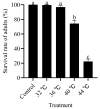The Impact of High-Temperature Stress on the Growth and Development of Tuta absoluta (Meyrick)
- PMID: 38921138
- PMCID: PMC11203633
- DOI: 10.3390/insects15060423
The Impact of High-Temperature Stress on the Growth and Development of Tuta absoluta (Meyrick)
Abstract
Insect life processes and reproductive behaviors are significantly affected by extremely high temperatures. This study focused on Tuta absoluta, which poses a severe threat to tomato cultivars. The effects of intense heat stress on the growth, development, oviposition, and longevity of T. absoluta were investigated. This investigation encompassed various developmental stages, including eggs, pupae, and adults. This study revealed that egg hatching and pupa emergence rates were significantly reduced at a temperature of 44 °C maintained for 6 h. The longevity of adults that emerged after the egg and pupal stages were exposed to 44 °C for 6 h was significantly reduced compared to the control. Notably, there was no significant variation in adult fecundity after egg-stage exposure to high temperatures. However, all treatments exhibited significantly reduced fecundity compared to the control after exposure to high temperatures during the pupal stage. Adult survival rates after exposure to 40 °C and 44 °C for 3 h were 74.29% and 22.40%, respectively, dramatically less than that of the control, which was 100%. However, no significant differences were noted in terms of longevity and egg production. These results offer a better understanding of the complex interactions between extreme temperatures and the life history traits of T. absoluta, thereby offering valuable insights for implementing management strategies to alleviate its impact on tomato crops in response to climate change.
Keywords: Tuta absoluta; growth and development; high-temperature stress; survival rate.
Conflict of interest statement
The authors declare no conflicts of interest.
Figures





References
-
- Khaliq A.M., Javed M., Sohail M., Sagheer M. Environmental effects on insects and their population dynamics. J. Entomol. Zool. Stud. 2014;2:1–7.
-
- Harvey J.A., Tougeron K., Gols R., Heinen R., Abarca M., Abram P.K., Chown S.L. Scientists’ warning on climate change and insects. Ecol. Monogr. 2023;93:e1553. doi: 10.1002/ecm.1553. - DOI
-
- Nie P.C., Yang R.L., Zhou J.J., Dewer Y., Shang S.Q. Elucidating the Effect of Temperature Stress on the Protein Content, Total Antioxidant Capacity, and Antioxidant Enzyme Activities in Tetranychus urticae (Acari: Tetranychidae) Insects. 2023;14:429. doi: 10.3390/insects14050429. - DOI - PMC - PubMed
Grants and funding
LinkOut - more resources
Full Text Sources

